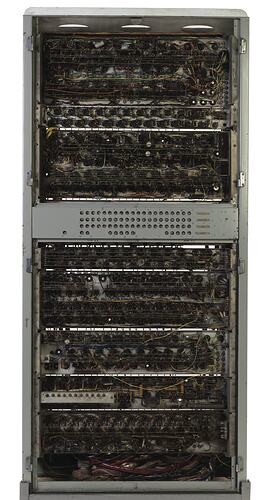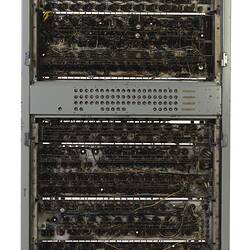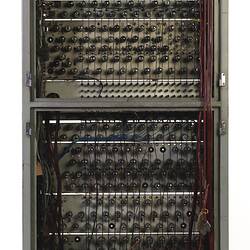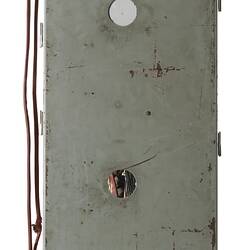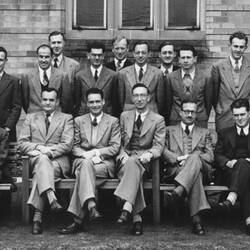Summary
Cabinet holding the input and output control circuitry for CSIRAC (formerly CSIR Mk 1). The input devicess were 5-hole and 12-hole paper tape readers. The outputs were 5-hole and 12-hole paper tape punches and a teleprinter, which, in Melbourne, was located on the control cconsole.
CSIRAC at Melbourne consisted of two rows of cabinets, a control console, input and output devices, test equipment and an off-line paper tape editing area. There were nine cabinets, five in the front row and four in the back. Cool air was blown up through all the cabinets from the basement below. The auxiliary memory (disk drive) occupied the space that would have been occupied by a cabinet in the back row.
The five front row cabinets contained (from left to right viewed from the front) power supplies, input and output circuitry, clock and control circuits, arithmetical circuits and memory control circuits. The four back row cabinets contained (from left to right viewed from the front) power supplies, auxiliary store control circuits, 'disk drive', auxiliary test power supplies and memory control circuits.
The date range (1949-1964) is given to indicate that, although the metal cabinets were first used in 1949, changes were made to the structure and circuitry over the period of CSIRAC's working life.
Physical Description
Grey metal cabinet. It has doors on the front and the back. It now sits on a purpose built collection management stillage.
Significance
CSIRAC was the fourth stored program computer in the world and the first one in Australia. It is the only intact first generation computer left on the planet.
More Information
-
Collection Names
-
Collecting Areas
-
Acquisition Information
Donation from Commonwealth Scientific & Industrial Research Organisation (CSIRO), Frank Hirst - University of Melbourne (The), Mar 1965
-
Designer
-
Designer
-
Commissioned By
Commonwealth Scientific & Industrial Research Organisation (CSIRO), Sydney, Greater Sydney, New South Wales, Australia, 1947
-
User
University of Melbourne (The), Grattan Street, Parkville, Greater Melbourne, Victoria, Australia, 1955-1964
-
Classification
-
Category
-
Discipline
-
Type of item
-
Exhibition Collection Management
505 mm (Length), 1020 mm (Width), 2195 mm (Height), 195 kg (Weight)
H 2350 mm with stillage; W 1040 mm with stillage
-
References
[Book] McCann, Doug & Thorne, Peter. 2000. The Last of the First CSIRAC: Australia's First Computer. 196., 2000, 12 Pages
-
Keywords
Computers, Computing, CSIRAC (Computer), Making History - CSIRAC
